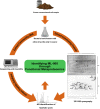Characterization of ML-005, a Novel Metaproteomics-Derived Esterase
- PMID: 30210461
- PMCID: PMC6119806
- DOI: 10.3389/fmicb.2018.01925
Characterization of ML-005, a Novel Metaproteomics-Derived Esterase
Erratum in
-
Corrigendum: Characterization of ML-005, a Novel Metaproteomics-Derived Esterase.Front Microbiol. 2018 Nov 14;9:2716. doi: 10.3389/fmicb.2018.02716. eCollection 2018. Front Microbiol. 2018. PMID: 30479613 Free PMC article.
Abstract
A novel gene encoding for a lipolytic enzyme, designated ML-005, was recently identified using a functional metaproteomics approach. We heterologously expressed this protein in Escherichia coli and biochemically characterized it. ML-005 exhibited lipolytic activity toward short-chained substrates with the preferred substrate being p-nitrophenyl-butyrate, suggesting that ML-005 is an esterase. According to homology analysis and site-directed mutagenesis, the catalytic triad of the enzyme was identified as Ser-99, Asp-164, and His-191. Its optimal pH was determined to be at pH 8. Optimal activity was observed at 45°C. It also exhibited temperature, pH and salt tolerance. Residual relative activity after incubating at 50-60°C for 360 min was above 80% of its initial activity. It showed tolerance over a broad range of pH (5-12) and retained most of its initial activity. Furthermore, incubating ML-005 in 1 - 5M NaCl solution had negligible effect on its activity. DTT, EDTA, and ß-mercaptoethanol had no significant effect on ML-005's activity. However, addition of PMSF led to almost complete inactivation consistent with ML-005 being a serine hydrolase. ML-005 remains stable in the presence of a range of metal ions, but addition of Cu2+ significantly reduces its relative activity. Organic solvents have an inhibitory effect on ML-005, but it retained 21% of activity in 10% methanol. SDS had the most pronounced inhibitory effect on ML-005 among all detergents tested and completely inactivated it. Furthermore, the Vmax of ML-005 was determined to be 59.8 μM/min along with a Km of 137.9 μM. The kcat of ML-005 is 26 s-1 and kcat/Km is 1.88 × 105 M-1 s-1.
Keywords: biocatalysis; esterase; lipase; metagenomics; metaproteomics.
Figures






Similar articles
-
Metaproteomic Discovery and Characterization of a Novel Lipolytic Enzyme From an Indian Hot Spring.Front Microbiol. 2021 Jun 4;12:672727. doi: 10.3389/fmicb.2021.672727. eCollection 2021. Front Microbiol. 2021. PMID: 34149658 Free PMC article.
-
Purification and characterization of an extracellular esterase with organic solvent tolerance from a halotolerant isolate, Salimicrobium sp. LY19.BMC Biotechnol. 2013 Dec 10;13:108. doi: 10.1186/1472-6750-13-108. BMC Biotechnol. 2013. PMID: 24325447 Free PMC article.
-
Characterization of a cold-active and salt tolerant esterase identified by functional screening of Arctic metagenomic libraries.BMC Biochem. 2016 Jan 19;17:1. doi: 10.1186/s12858-016-0057-x. BMC Biochem. 2016. PMID: 26782782 Free PMC article.
-
Cloning, expression and characterization of the esterase estUT1 from Ureibacillus thermosphaericus which belongs to a new lipase family XVIII.Extremophiles. 2018 Mar;22(2):271-285. doi: 10.1007/s00792-018-0996-9. Epub 2018 Jan 12. Extremophiles. 2018. PMID: 29330648
-
Novel organic solvent-tolerant esterase isolated by metagenomics: insights into the lipase/esterase classification.Rev Argent Microbiol. 2013 Jan-Mar;45(1):3-12. Rev Argent Microbiol. 2013. PMID: 23560782
Cited by
-
Exploring the Enzymatic and Antibacterial Activities of Novel Mycobacteriophage Lysin B Enzymes.Int J Mol Sci. 2020 Apr 30;21(9):3176. doi: 10.3390/ijms21093176. Int J Mol Sci. 2020. PMID: 32365915 Free PMC article.
-
Metaproteomic Discovery and Characterization of a Novel Lipolytic Enzyme From an Indian Hot Spring.Front Microbiol. 2021 Jun 4;12:672727. doi: 10.3389/fmicb.2021.672727. eCollection 2021. Front Microbiol. 2021. PMID: 34149658 Free PMC article.
-
A hydrolase with esterase activity expressed from a fosmid gene bank prepared from DNA of a North West Himalayan glacier frozen soil sample.3 Biotech. 2019 Mar;9(3):107. doi: 10.1007/s13205-019-1621-z. Epub 2019 Feb 26. 3 Biotech. 2019. PMID: 30863691 Free PMC article.
-
Screening of marine sediment-derived microorganisms and their bioactive metabolites: a review.World J Microbiol Biotechnol. 2023 Apr 28;39(7):172. doi: 10.1007/s11274-023-03621-4. World J Microbiol Biotechnol. 2023. PMID: 37115432 Review.
References
-
- Abramić M., Leščić I., Korica T., Vitale L., Saenger W., Pigac J. (1999). Purification and properties of extracellular lipase from Streptomyces rimosus. Enzyme Microb. Technol. 25 522–529. 10.1016/S0141-0229(99)00077-0 - DOI
-
- Awaji H., Fujita Y., Heldt-Hansen H. P., Sharyou M., Shimoto H., As N. N., et al. (1998). Lipase-catalyzed ester hydrolysis.
Grants and funding
LinkOut - more resources
Full Text Sources
Other Literature Sources
Miscellaneous

